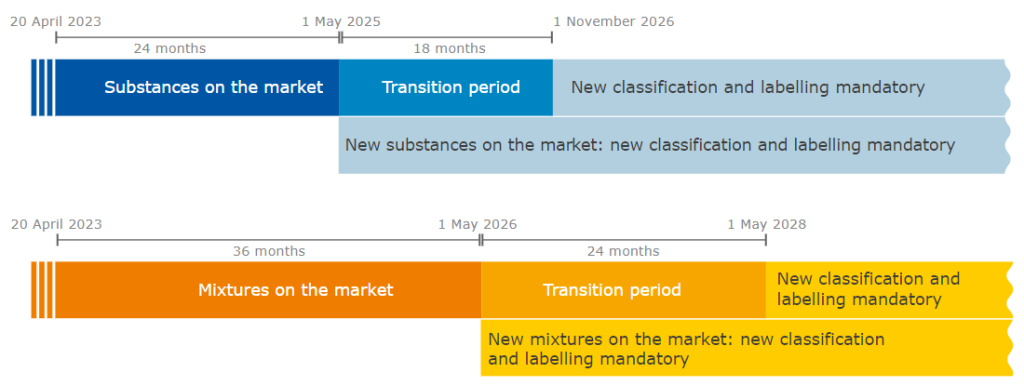Komisja Europejska opublikowała delegowane rozporządzenie zmieniające rozporządzenie CLP, które określa nowe klasy zagrożenia oraz kryteria klasyfikacji, oznakowania i pakowania substancji i mieszanin.
Ma ono zastosowanie do wszystkich substancji chemicznych i mieszanin wprowadzanych do obrotu w UE na mocy rozporządzenia REACH. Rozporządzenie stosuje się również w przypadku substancji czynnych w produktach biobójczych i środkach ochrony roślin, które zwykle traktowane są priorytetowo w ramach zharmonizowanej klasyfikacji w UE.
ECHA udziela porad dotyczących nowych klas zagrożenia dla substancji i mieszanin.
20 kwietnia 2023 r. wchodzą w życie trzy nowe klasy zagrożenia dotyczące klasyfikacji, oznakowania i pakowania (CLP). ECHA opublikowała także informacje na temat terminów stosowania oraz powiązane z rozporządzeniem poradniki.
Komisja Europejska zaktualizowała rozporządzenie w sprawie klasyfikacji, oznakowania i pakowania o następujące klasy zagrożenia:
• substancje zaburzające funkcjonowanie układu hormonalnego w odniesieniu do zdrowia ludzkiego i środowiska endocrine disruptors (ED) for human health or the environment;
• persistent, bioaccumulative and toxic (PBT); very persistent and very bioaccumulative (vPvB); and
• persistent, mobile and toxic (PMT); very persistent and very mobile (vPvM).
Companies and Member State authorities can use current guidance on identifying endocrine disruptors and on PBT (persistence, bioaccumulation, toxicity) assessment until the guidance on applying the CLP criteria has been updated. It is expected to be ready in 2024. and make their dossiers comply with the information requirements, where needed.
What are the obligations for companies following the entry into force of the Commission Delegated Regulation (EU) 2023/707 of 19 December 2022?
Weblink: https://qnapublic.echa.europa.eu/?ids=2006
Answer:
Once the Delegated Regulation 2023/707 enters into force (20 April 2023), manufacturers, importers, downstream users and distributors should consider the following tasks in order to comply with their duties. The exact order and timing will depend on the specific scenario of each operator: if they place on the market substances or mixtures; if they are members of a joint submission or not; if their substance or mixture is already placed on the market or not, etc. The list is not exhaustive but lists the main tasks triggered by the new legal text.
Review the classification and labelling of the substances and mixtures in their portfolio against the criteria of the new hazard classes. They should use all available information for self-classification.
Take note of the transitional periods for substances and mixtures that apply to them and make sure they have fulfilled their duties at the latest by those dates. Transitional periods allow to comply earlier and avoid last-minute difficulties.
If they are part of a joint submission under REACH, initiate the discussion to agree on the classification and labelling of their substances. Update the registration dossier without undue delay, as outlined in the Implementing Regulation 2020/1435.
If they are part of a group of manufacturers/importers for the purpose of C&L notification, initiate the discussion to agree on the classification and labelling of their substances. Update the notification to the inventory accordingly.
Contact the other notifiers for the same substance to agree on the new classification and labelling. The leader of the joint submission, or the leader of the group of manufacturers/importers, if the operator is a member of either, can help in such communication.
Revise their labels, for both substances and mixtures.
Update, when relevant, any poison centre notification they have already made, with the new hazard information.
Consider whether a new poison centre notification is needed. Mixtures previously not classified for human health nor physical hazards may have to be classified for the new human health hazards from 1 May 2026.
Update their safety data sheets (SDS) with the new classification and labelling, and all relevant new information that is needed to reflect the new hazards. They may need to compile an SDS for substances or mixtures which were previously not classified.
Prepare to compile and provide an SDS upon request if their mixtures are not classified but contain a substance in 0,1% or more of an endocrine disruptor Category 2 and is not intended for the general public.
Transitional periods:

Full article ECHA: https://echa.europa.eu/sk/-/echa-provides-advice-on-new-hazard-classes-for-substances-and-mixtures
Ekotox Centers EU SDS/CLP webpages: https://ekotox.eu/safety-data-sheet-sds/
Training: EU SDS Compliance *Webinar*: https://ekotoxtraining.com/events/eu-sds-compliance-webinar-2/
